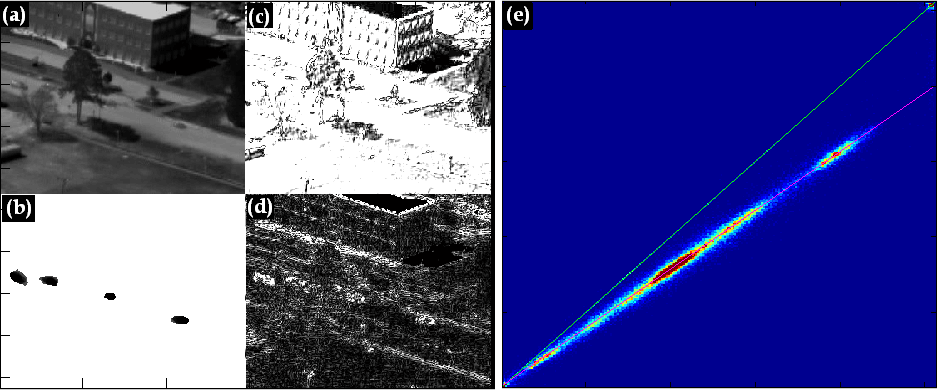Research
|
Tracking Vehicles in Airborne Video Imagery
|
Background Estimation under Rapid Gain Change in Thermal Imagery
|

Dense Estimation of Motion and Appearance
|
|
Separating images into background/ foreground layers and
improving the stability of optical flow.
|
To model appearance change in image sequences and separate
them into depth layers, we worked on learning and adapting
information in image sequences by formulating the optical flow
problem in a Bayesian framework.
We first developed a probabilistic model of optical flow. Then we extended the Bayesian framework for dense motion estimation to appearance estimation and finally developed a Bayesian framework to simultaneously estimate the appearance of multiple image layers and their corresponding dense flow fields from image sequences. Our objective is to separate image sequences into layers (e.g. background or foreground for a simple two-layer case), model the appearance of each layer and characterize the motion in different layers. Currently, we are exploiting our framework to explain occlusions/disocclusions in image sequences. We are also investigating the improvement of the stability of optical flow estimates by estimating an appearance model that captures the structure of the image texture being tracked. ( More about it... ) |
Implicitization of parametric curves by matrix annihilation
|

Implicit representation of curves using Matrix Annihilation.
|
Shapes of objects can be represented either explicitly or implicitly.
The general process of converting parametric equations
of curves and surfaces to implicit ones, also known as implicitization,
has been studied more than a century.
Implicitization techniques based on elimination theory involve
computing the determinant of Sylvester's matrix which contains
symbolic variables.
Here we use elliptic Fourier descriptors to parametrically represent curves.
We developed a new non-symbolic implicitization technique called the matrix annihilation method, for converting parametric Fourier representations to implicit polynomial representations to provide a means of benefiting from the features of both. Our method is numerical, so that we can parametrize more complex curves with higher order polynomial degrees than previously possible. Furthermore, our procedure is computationally efficient. ( More about it ... ) |
Precise modeling & measurement of free-form surfaces using implicit polynomials
|
|
Precision measurement on implicitly defined surfaces.
|
We have done some research on precise modeling and measurement
of free-form curves and surfaces using
implicit polynomial equations.
We developed an iterative procedure to compute the approximate perpendicular distance between an external point and an implicit polynomial curve using Newton's successive approximation procedure. We then employed this procedure to compute the error between the measured points on a surface and the implicitly modeled ideal surface. We also developed a procedure for generating a sequence of points that the stylus of a Coordinate Measuring Machine (CMM) can follow along a curve or surface defined by an implicit polynomial equation. ( More about it ... ) |
Automated Recognition and Sorting of Remote Control Devices
|
|
Automatic recognition and sorting system
|
We developed an automated visual inspection system for
BEKO International, Inc.
– a large manufacturing company that
produces home appliances. The task was to sort remote
control devices on the assembly line
(four thousand of them in eight hours).
The visual processing of the inspection system was based on the shape assessment algorithm in my thesis. To manage time constraints, we used selective perception and potential functions in our algorithm and implemented it with Matrox Imaging card. This system was among the five finalist, in the national best industrial project competition in 1999. ( More about it ... ) |
2D Shape Assessment using Selective Fixations and Artificial Potential Functions
|
|
Sequence of fixation points generated.
|
For human visual behaviour, selectively gathering information
about the environment is characterized by the ability to fixate
on a point of interest and the ability to select new fixation
locations. Motivated by human visual system, we first developed
a heuristic algorithm where only the areas that are deemed
"interesting" are fixated and analyzed. The attentional sequences
thus generated are then used for a variety of tasks including shape
determination.
We participated (team leader) in Texas Instruments International DSP Challenge '97 with the project "BUVIS - A Novel Approach to Real-Time Automated Visual Inspection" which was based on the heuristic algorithm. We then formulated this heuristic algorithm in a mathematical framework and constructed the underlying theory of selective fixation control using artificial potential functions. This approach has been implemented for a remote controller manufacturing line in the TV industry. ( More about it ... ) |
Resume
| Research
| Main Page
Carnegie Mellon University, Robotics Institute
5000 Forbes Av., Pittsburgh, PA, 15213
hulyayalcin@gmail.com